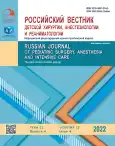Одноэтапная трансскротальная орхиопексия при двустороннем паховом крипторхизме у детей
- Авторы: Акрамов Н.Р.1,2,3, Хаертдинов Э.И.1,3, Поспелов М.С.3, Рахматуллаев А.А.4, Исроилов А.А.4,5
-
Учреждения:
- Казанская государственная медицинская академия — филиал Российской медицинской академии непрерывного профессионального образования
- Республиканская клиническая больница
- Детская республиканская клиническая больница
- Ташкентский педиатрический медицинский институт
- Юнусабадский медицинский центр
- Выпуск: Том 12, № 4 (2022)
- Страницы: 411-418
- Раздел: Оригинальные исследования
- URL: https://bakhtiniada.ru/2219-4061/article/view/233289
- DOI: https://doi.org/10.17816/psaic1302
- ID: 233289
Цитировать
Полный текст
Аннотация
Актуальность. Частота крипторхизма варьирует и зависит от гестационного возраста, поражая 1,0–4,6 % доношенных и 1,1–45 % недоношенных новорожденных. Лечение данного порока в настоящее время хирургическое. Орхиопексия — одно из частых хирургических пособий в практике детского хирурга и детского уролога-андролога. Необходимость при двустороннем паховом крипторхизме выполнять несколько разрезов или разделять операции с каждой стороны по времени заставляют хирургов продолжать поиски оптимального способа коррекции этой патологии.
Цель — определить возможности фиксации обоих яичек при двустороннем крипторхизме в физиологическом положении в мошонке через один хирургический доступ с меньшим количеством осложнений и улучшенным косметическим результатом в сравнении с предложенными ранее способами.
Материалы и методы. С 2012 по 2021 г. нами пролечено 92 ребенка мужского пола с двусторонним паховым крипторхизмом. Всем мальчикам выполняли разработанный способ одноэтапной трансскротальной двусторонней орхиопексии, при необходимости сопровождающийся лапароскопическим ассистированием по методике однотроакарного лапароскопического доступа.
Результаты. Представлены результаты лечения 92 детей с двусторонним паховым крипторхизмом (184 гонады) в условиях нескольких клиник с использованием данного способа. Благодаря усовершенствованию технологии орхиопексии в виде однотроакарного лапароскопического ассистирования в случаях, не позволяющих свободно низвести яичко в мошонку, уменьшилось количество осложнений, связанных с хирургическим доступом, таких как выраженный послеоперационный отек и воспаление области послеоперационной раны до 1,62 % случаев, и отсутствовали рецидивы заболевания и персистирующие паховые грыжи.
Заключение. В статье описан новый способ одноэтапной трансскротальной орхиопексии с лапароскопическим ассистированием и статистически обосновано его применение при двустороннем паховом крипторхизме, позволяющий произвести фиксацию обоих яичек в физиологическом положении в мошонке при любом положении яичек в паховой области с меньшим количеством осложнений и улучшенным косметическим результатом в сравнении с предложенными ранее способами.
Ключевые слова
Полный текст
Открыть статью на сайте журналаОб авторах
Наиль Рамилович Акрамов
Казанская государственная медицинская академия — филиал Российской медицинской академии непрерывного профессионального образования; Республиканская клиническая больница; Детская республиканская клиническая больница
Автор, ответственный за переписку.
Email: aknail@rambler.ru
ORCID iD: 0000-0001-6076-0181
SPIN-код: 9243-3624
д-р мед. наук, профессор
Россия, 420012, Казань, ул. Бутлерова, д. 36; Казань; КазаньЭльмир Ильшатович Хаертдинов
Казанская государственная медицинская академия — филиал Российской медицинской академии непрерывного профессионального образования; Детская республиканская клиническая больница
Email: khelmir@yandex.ru
ORCID iD: 0000-0001-8776-0325
SPIN-код: 4434-5214
канд. мед. наук, детский хирург
Россия, 420012, Казань, ул. Бутлерова, д. 36; КазаньМихаил Сергеевич Поспелов
Детская республиканская клиническая больница
Email: pms1978@mail.ru
ORCID iD: 0000-0002-9819-3319
заместитель главного врача по хирургии
Россия, КазаньАкмал Абадбекович Рахматуллаев
Ташкентский педиатрический медицинский институт
Email: akmalrakhmatullaev@mail.ru
ORCID iD: 0000-0003-4408-5723
SPIN-код: 7130-1544
д-р мед. наук, доцент
Узбекистан, ТашкентАброжон Адилжонович Исроилов
Ташкентский педиатрический медицинский институт; Юнусабадский медицинский центр
Email: abrorjon3112@gmail.com
ORCID iD: 0000-0002-9640-3490
детский хирург
Узбекистан, Ташкент; ТашкентСписок литературы
- Admayr C, Dogan HS, Hoebeke P, et al. Management of undescended testes: European Association of Urology/European Society for Paediatric Urology Guidelines. J Pediatr Urol. 2016;12(6):335–343. doi: 10.1016/j.jpurol.2016.07.014
- Berkowitz GS, Lapinski RH, Dolgin SE, et al. Prevalence and natural history of cryptorchidism. Pediatrics. 1993;92(1):44–49.
- Elder JS. Surgical management of the undescended testis: recent advances and controversies. Eur J Pediatr Surg. 2016;26(5):418–426. doi: 10.1055/s-0036-1592197
- Khramov EB, Akselrov MA, Shaitarova AV, Grigoruk EKh. Cryptorchidism in children: the practice of specialists in the diagnosis and treatment of diseases. Medical Science and Education of Urals. 2018;3:174–179. (In Russ.)
- Patent RU 2566495 C2/10.27.2015. Akramov NR, Yafyasov RYa, Podshivalin AA, et al. Sposob laparoskopicheski assistirovannoi igniopunkturnoi ekstraperitoneal’noi gerniorafii pri vrozhdennykh pakhovykh gryzhakh u detei. Available from: https://patenton.ru/patent/RU2566495C2 (In Russ.)
- Schuller M. On inguinal testicle and its operative treatment by transplantation into the scrotum. Ann Anat Surg. 1881;4:89–102.
- Bevan AD. Operation for undescended testicle and congenital inguinal hernia. JAMA. 1899;33:773–777.
- Moul JW, Belman AB. A review of surgical treatment of undescended testes with emphasis on anatomical position. J Urol. 1988;140(1):125–128. doi: 10.1016/s0022-5347(17)41504-7
- Misra D, Dias R, Kapila L. Scrotal fixation: a different surgical approach in the management of the low undescended testes. Urology. 1997;49(5):762–765. doi: 10.1016/S0090-4295(97)00071-X
- Bianchi A, Squire BR. Transscrotal orchidopexy: orchidopexy revised. Pediatr Surg Int. 1989;4:189–192.
- Lais A, Ferro F. Trans-scrotal approach for surgical correction of cryptorchidism and congenital anomalies of the processus vaginalis. Eur Urol. 1996;29(2):235–239.
- Cloutier J, Moore K, Nadeau G, Bolduc S. Modified scrotal (Bianchi) mid raphe single incision orchiopexy for low palpable undescended testis: early outcomes. J Urol. 2011;185(3):1088–1092. doi: 10.1016/j.juro.2010.10.039
- Carney TB, Leuther PA, Marks MM. Transscrotal orchidopexy in adults. Am J Surg. 1946;72(5):715–718. doi: 10.1016/0002-9610(46)90348-0
- Kogan MI, Makarov AG, Sizonov VV, et al. The results of using the original technique of testicular fixation with transscrotal access in surgery for cryptorchidism in children. Experimental and Clinical Urology. 2021;14(1):151–155. (In Russ.) doi: 10.29188/2222-8543-2021-14-1-151-155
- Nazem M, Hosseinpour M, Alghazali A. Trans-scrotal incision approach versus traditional trans-scrotal incision orchiopexy in children with cryptorchidism: a randomized trial study. Adv Biomed Res. 2019;8:34. doi: 10.4103/abr.abr_26_19
- Wang YJ, Chen L, Zhang QL, et al. Transscrotal transverse incision for the treatment of middle and low cryptorchidism in children: experience from 796 cases. BMC Surg. 2020;20:51. doi: 10.1186/s12893-020-00710-1
- Spinelli C, Bertocchini A, Cito G, et al. The fat anchor orchiopexy technique: results and outcomes from 150 cases surgical experience. Pediatr Surg Int. 2022;38(2):351–356. doi: 10.1007/s00383-021-04919-w
- Hyuga T, Kawai S, Nakamura S, et al. Long-term outcome of low scrotal approach orchiopexy without ligation of the processus vaginalis. J Urol. 2016;196(2):542–547. doi: 10.1016/j.juro.2016.02.2962
- Sizonov VV, Orlov VM, Kogan MI. Complications after surgical treatment of cryptorchidism. Ural Medical Journal. 2017;2(146):126–129.
- Novaes HF, Carneiro Neto JA, et al. Single scrotal incision orchiopexy — a systematic review. Int Braz J Urol. 2013;39(3):305–311. doi: 10.1590/S1677-5538.IBJU.2013.03.02
Дополнительные файлы






